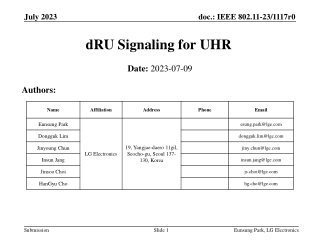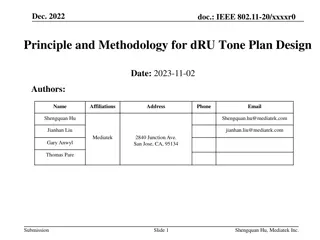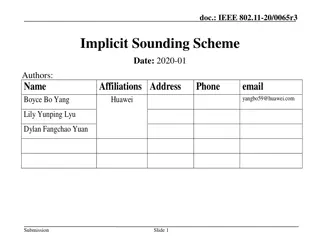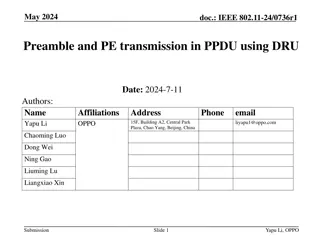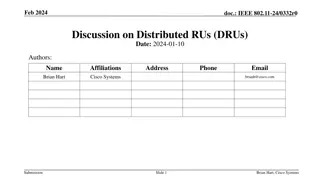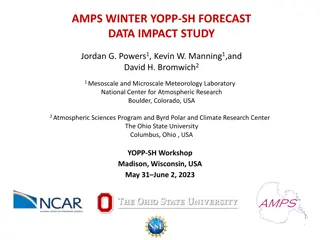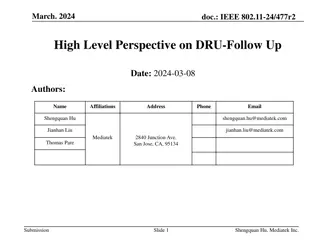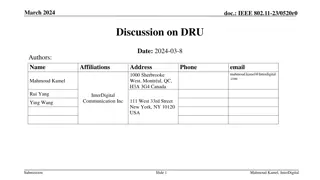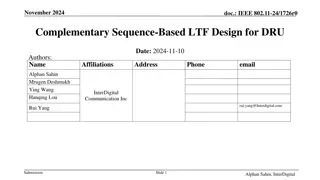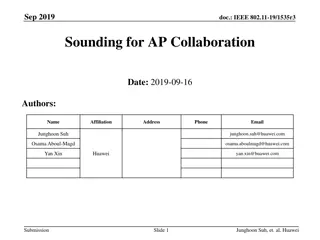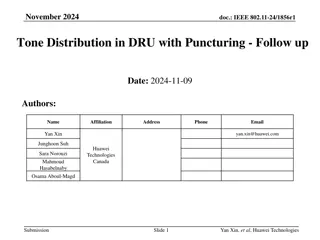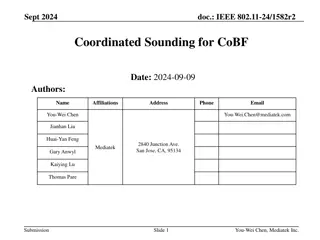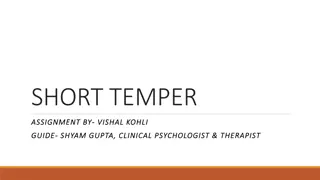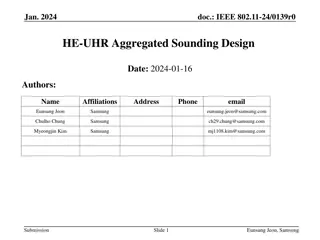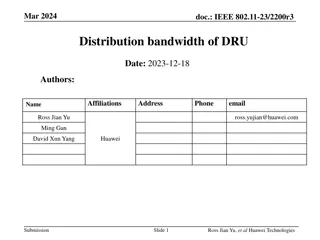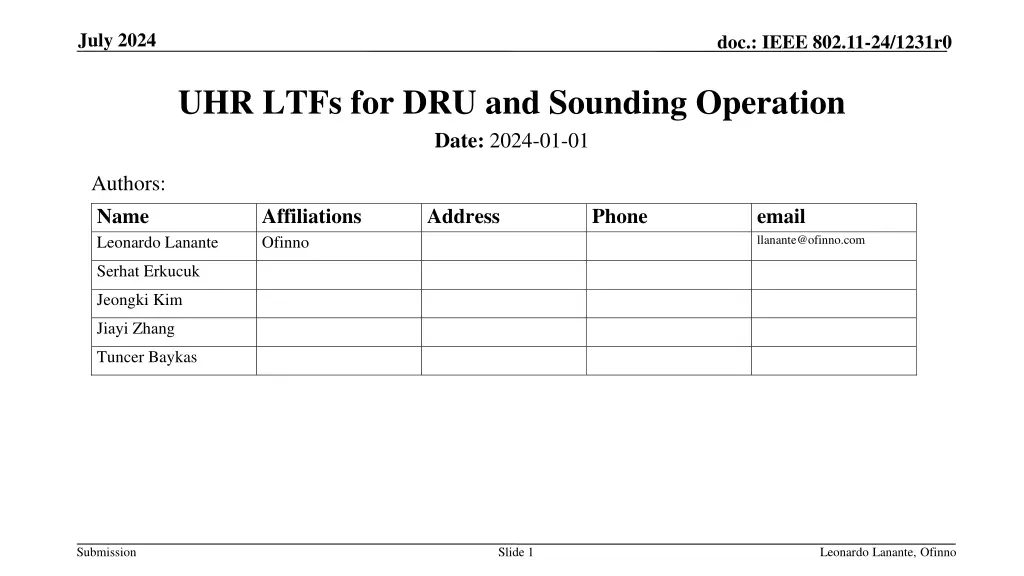
IEEE 802.11-24 July 2024 Document Insights
Explore the latest developments in IEEE 802.11-24 for Distributed Resource Units (DRU), Channel Estimate Smoothing, LTF Extension proposals, Sounding operations for Low Power IoT, and Compressed Beamforming Report. Stay informed on key advancements in wireless communication technology.
Download Presentation

Please find below an Image/Link to download the presentation.
The content on the website is provided AS IS for your information and personal use only. It may not be sold, licensed, or shared on other websites without obtaining consent from the author. If you encounter any issues during the download, it is possible that the publisher has removed the file from their server.
You are allowed to download the files provided on this website for personal or commercial use, subject to the condition that they are used lawfully. All files are the property of their respective owners.
The content on the website is provided AS IS for your information and personal use only. It may not be sold, licensed, or shared on other websites without obtaining consent from the author.
E N D
Presentation Transcript
July 2024 doc.: IEEE 802.11-24/1231r0 UHR LTFs for DRU and Sounding Operation Date: 2024-01-01 Authors: Name Leonardo Lanante Affiliations Ofinno Address Phone email llanante@ofinno.com Serhat Erkucuk Jeongki Kim Jiayi Zhang Tuncer Baykas Submission Slide 1 Leonardo Lanante, Ofinno
July 2024 doc.: IEEE 802.11-24/1231r0 Abstract Distributed resource units (DRU) uses distributed tones to boost transmit power in PSD limited operating classes. In this contribution, we present our thoughts regarding the LTF design using DRU. Submission Slide 2 Leonardo Lanante, Ofinno
July 2024 doc.: IEEE 802.11-24/1231r0 Channel Estimate Smoothing Channel smoothing is well known to provide PER performance by 1~2 dB depending on the MCS. Lower MCS performance is AWGN noise dominated and has higher PER gains. For DRU, the performance of channel smoothing may deteriorate due to sparse tone spacing. In [1], it was shown that on a 40 MHz PPDU, the channel smoothing gain reduces from 2.16 dB to 1.3 dB for 26-tone DRU vs 52-tone DRU. With reduced channel smoothing gains, LPI devices may experience lower SNR gains depending on the DRU tone spacing. Complicates scheduling and link adaptation decisions by the AP. Submission Slide 3 Leonardo Lanante, Ofinno
July 2024 doc.: IEEE 802.11-24/1231r0 Proposal: LTF extension for DRU PPDUs LTF extensions for DRU PPDU is a simple way to supplement the performance of channel estimation when a DRU allocated to a STA has a large tone spacing between two adjacent tones. The AP performs averaging of channel estimates from multiple LTF copies. We can extend the number of LTFs based on the largest tone spacing within the distribution bandwidth. For example, for an 80 MHz distribution bandwidth (assuming 1 spatial stream) with 242, 484 Tone DRU - 1 LTF 52, 106 Tone DRU 2 LTF 26 Tone DRU 4 LTF Changes in the standard can be as simple as mandating DRU capable stations to support a specific number of LTF extensions for DRU transmissions. Submission Slide 4 Leonardo Lanante, Ofinno
July 2024 doc.: IEEE 802.11-24/1231r0 Sounding NDP Transmit Boost for LPI operation NDP sounding is used to determine the channel state information. The beamformer transmits a sounding NDP and the beamformee sends back an estimate of the channel state. The feedback may be used for MU- MIMO beamforming or OFDMA RU allocation. NDP is an SU PPDU, and will be transmitted using RRU. Hence due to PSD restrictions in LPI, the channel feedback accuracy may suffer from low SNR. Submission Slide 5 Leonardo Lanante, Ofinno
July 2024 doc.: IEEE 802.11-24/1231r0 Compressed Beamforming Report The Compressed Beamforming Report field carries the average SNR of each spatial stream and compressed feedback matrices for use by a transmit beamformer to determine steering matrices , as described in 10.33.3 (Explicit feedback beamforming) and feedback beamforming). The Grouping subfield Ng indicates the subcarrier grouping, , used for the compressed beamforming feedback matrix: Set to 0 for Ng=4 Set to 1 for Ng=16 Ng=4 beamforming 19.3.12.3 (Explicit Ng=4 Compressed Beamforming Report Frequency Bandwidth Submission Slide 6 Leonardo Lanante, Ofinno
July 2024 doc.: IEEE 802.11-24/1231r0 Proposal Only tones corresponding to Ng=4 are used. One solution is to only transmit on subcarriers that will be sent as feedback in the compressed beamforming report. Similar to DRU, a transmit power boost can be obtained without defining an SU PPDU using DRU. For Ng = 4 and 20 MHz BW, the NDP transmit power can be 24 dBm (compared to 18 dBm using RRU) The NDPA frame indicates whether only tones where feedback is sent is used to transmit the NDP. avoids backward compatibility issues when a STA assumes all tones are used by the AP (e.g. channel estimate smoothing). NDP BFRP NDPA* AP Ng=4 BFR STA 1 BFR STA 2 BFR STA 9 Ng=4 Compressed Beamforming Report Frequency Bandwidth Submission Slide 7 Leonardo Lanante, Ofinno
July 2024 doc.: IEEE 802.11-24/1231r0 Conclusion Small size DRUs spread over a high bandwidth may be difficult to smoothen due to the tone spacing. We propose to solve the problem using LTF extensions for noise reduction of the channel estimates. In addition, NDPs may also gain additional transmit power boost in PSD limited operations by only transmitting at exact tones where feedback is explicitly solicited. Submission Slide 8 Leonardo Lanante, Ofinno
July 2024 doc.: IEEE 802.11-24/1231r0 References [1] https://mentor.ieee.org/802.11/dcn/23/11-23-2031-02-00bn-data-tones- grouping-in-tone-distributed-rus.pptx Submission Slide 9 Leonardo Lanante, Ofinno

